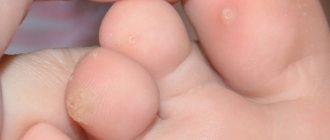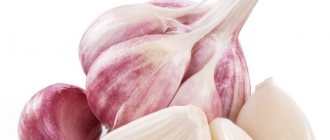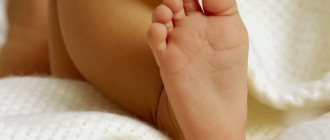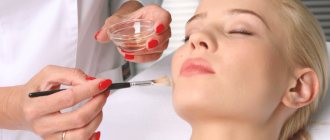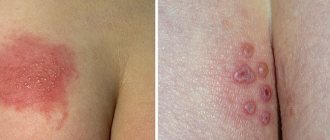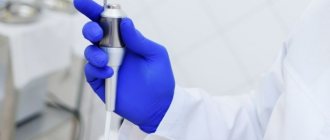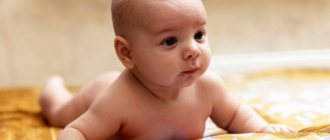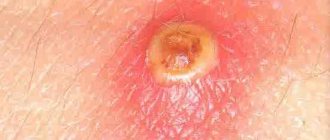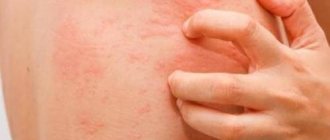There are probably people among us who do not even suspect the existence of such an insect as the body louse. This parasite should not be confused with a head or pubic louse, but then it is worth figuring out what kind of creature it is and where exactly it can be found.
What does an insect look like, photo
A louse is an insect that parasitizes the human body, feeding on its blood. The body louse, unlike the pubic and head louse, lives outside its owner: in linen, in bed, in the folds of clothing, and only visits a person occasionally in order to once again feed on his health. It is very difficult to notice and examine the insect with the naked eye due to its small size, but examination under a magnifying glass has identified some external features that do not allow the body louse to be confused with any other parasite.
Body lice are very similar to head lice, but they differ from the latter in their larger sizes: for example, their body length is only about 4 mm. The insect is characterized by a transparent grayish-yellowish or whitish color, making them almost invisible. The louse has an elongated abdomen and a very small head with antennae; the parasite has no wings. The insect's legs are designed in such a way that they are not able to cling to human hair, so body lice are forced to live in fabrics. The oral apparatus of insects is characterized as piercing-sucking; the insect literally pierces human skin using special piercing needles and sucks blood through a thin proboscis.
The life cycle of the parasite is only 30-35 days, but in such a short period one female manages to lay up to 300-400 eggs, and in one day – up to 5-14. Body louse eggs are also called nits; they are attached to clothing with a special enzyme, an adhesive substance, so it is sometimes very difficult to easily tear them off from the fibers of the fabric. The shape of the eggs is similar to an elongated grain, and the size is striking in its tinyness - it is only 0.5 mm. Body lice larvae (the stage of development following the egg) are also small - usually their body size does not exceed 1.5-2 mm.
Sometimes this insect is confused with a flea, especially after the adult has had its fill of blood and its abdomen has noticeably darkened. The main difference in this case is the inability of the louse to jump, if the parasites simply crawl away from the bite site - these are certainly not fleas. It is also not difficult to differentiate between a bedbug and a body louse: bedbugs are much larger than lice, and their abdomen is darker in color. There is a similarity with a tick, but a louse can be distinguished from it by the number of legs: if a tick has 8, then a louse has only 6.
What is a body louse
Body lice belong to the class of insects and order of lice that are hematophagous by nature, since their food source is exclusively human blood. These parasites can also rightly be considered head lice, which over a certain period of time have evolved and changed their lifestyle. The main difference between a body louse and a head louse is its smooth legs without characteristic scales; this feature is explained by the lack of need to move through slippery human hair.
The body louse spends most of its time in the folds of clothing, between seams, under the collar, and also in bedding, for which it received another name - body or linen louse. Only a few times a day the parasite moves to the human skin to get its food, but if food is absent for 4-5 days, the insect will certainly die.
An interesting fact is that body lice prefer cotton and woolen clothing, the fibers of which are easier for them to cling to with their paws, but silk and sliding fabrics are completely uninteresting to the parasites. In addition, the sharp and rich aroma of perfume only attracts insects, and does not repel them, as many people think.
The most favorable conditions for normal life and reproduction of body lice are temperatures from +30 to +33 C, but a threshold below -13 C and above +60 C is fatal for these parasites. Thanks to this feature, you can fight body lice by freezing or simply washing clothes and linen in hot water.
A comfortable habitat for insects, as a rule, is determined by dirty clothes, so the main category of people suffering from parasites are beggars, tramps and refugees who are deprived of the opportunity to regularly wash and change their things.
However, sometimes very clean people can get body lice if they come into close contact with insect carriers or visit characteristic places, which are the following:
- crowded public transport, including trains;
- apartments with dysfunctional families;
- cheap hotels or hostels;
- summer camps and recreation centers;
- public baths and saunas;
- reservoirs with stagnant water;
- used clothing stores;
- places of detention, as well as barracks.
To prevent the rapid spread of these parasites, it is necessary not only to observe the rules of personal hygiene, but also to be on alert if strange spots and redness appear on the body. Many people attribute such symptoms to allergies or mosquito bites, without thinking at all that the real cause may be body lice.
Who is sick and how is it transmitted?
The body louse must feed on blood several times a day, so the proximity of the human body is an important factor for it. Insects parasitize exclusively on those people who rarely change their clothes. Their main victims are tramps, homeless people and soldiers participating in military operations who do not change clothes regularly.
The most favorable temperature for their life and reproduction is +30-33ºС. When the temperature drops below -13 ºС or rises above +60 ºС, the lice die, which can help a person rid things of annoying bloodsuckers. If clothes with parasites are removed and hung in a closet for several days, the insect dies from starvation.
Lice are transmitted and you can get body lice only through close contact with a sick person or when wearing someone else's clothes in places such as:
- refugee camps;
- kindergartens and schools;
- places where homeless people sleep;
- tents in a war zone;
- transport where many people travel, incl. trains;
- baths and saunas;
- children's and sports camps;
- tourist travel;
- cheap hotels where there are no sanitary conditions.
Symptoms
Most often, people infected with parasites find bites that are accompanied by itching and rashes. At the initial stage, such manifestations may not be given much importance, but as the lice spread, the area of affected areas on a person’s skin will only increase, causing more and more discomfort and causing unpleasant consequences.
In such a situation, it is necessary to consult a specialist as soon as possible, but if for some reason the trip to the doctor is delayed, you can use the elimination method. First, you need to understand what the clinical picture is - an allergy or actual bites. The allergy affects larger areas and looks like continuous redness, and the bites are local in nature. In addition, body lice bites have a pronounced puncture point in the center of the inflamed area.
The fact is that the insect’s proboscis is quite short and in the process of digging into the skin the parasite has to immerse part of its head inside, thereby enlarging the puncture hole. It is also easy to distinguish between a bedbug bite and a body louse bite. Bedbugs bite people in open areas of the body that are not covered by any clothing, usually the arms, legs and neck. But body lice, on the contrary, attack those areas of the body that come into contact with clothing: shoulders, back, armpits, stomach and lower back, hips. Moreover, the areas least likely to be affected are areas where there is hair.
A special sign of the bites of these parasites is a change in skin color, which is characterized by the appearance of bluish spots. This fact can be explained by the fact that when a body louse bites, it injects a special enzyme that destroys hemoglobin in the blood; it is its breakdown products that accumulate under the skin and give it a blue tint. It is worth keeping in mind one more feature: damage to the skin by these parasites looks very much like flea bites, however, body lice bites differ from the latter in their random arrangement, and not in a characteristic chain, according to the principle of which bed bugs also usually bite.
After making sure that the body is covered with bites, you need to examine your sleeping place, bedding and clothes. As a rule, adult lice can be seen with the naked eye, but lice eggs can only be seen by a person armed with a magnifying glass. When these parasites are detected, the fight must begin immediately, without waiting for possible complications.
What do body louse bites look like and what to do with the affected area?
body lice - photo of bites
In the area affected by bites there are areas of the human body that are in direct contact with clothing. The parasite chooses the shortest path from its home in the form of a fold to the open surface of the skin. Most often, the lower back, groin area, neck from the collar side, and the entire back area are affected. Therefore, if bite marks are found on the body, then the parasite should be looked for on the inside of clothing in the same area. The dress louse bites hard and deeply. During the bite, she injects some of her saliva into the wound, which has an anesthetic effect.
That is why a person does not feel any pain symptoms for a while, and the insect is saturated with blood during this period. Only after a while, when the skin has already been damaged, the patient begins to feel severe itching, which forces him to scratch the bitten skin. This later leads to scratching.
Often, dermatological inflammation develops in such places, triggered by infection, which occurs as a result of contact with a parasite, or with dirty hands.
The bite sites take on the appearance of a red and swollen elevation above the general layer of skin. The edges of the inflammatory formation have a bluish tint. It is painful on palpation despite the fact that there is a feeling of severe itching. As the damaged skin heals, it may peel off. In order for healing of damaged skin to occur, it is necessary to wipe it as quickly as possible with a 3% solution of hydrogen peroxide, salicylic acid, boric or camphor alcohol. To reduce the pathological feeling of itching, antihistamines Suprastin, L-cet, Ketotifen, Eden, Suprastinol, Aleron are used.
Bites, photo
Body lice bites are characterized primarily by severe itching, which occurs due to the fact that when the insect punctures the skin, it injects an anesthetic substance into the wound, which helps stop blood clotting. Often the human body reacts to this enzyme with an allergic reaction, manifested in the form of acute urticaria. Burning and discomfort force the victim to comb the affected areas of the skin, which inevitably leads to excoriation, that is, its damage. Open wounds become a path for the penetration of bacteria, causing the appearance of pustular formations - the so-called phenomenon of pyoderma.
If you ignore the process for a long time and neglect it too much, unwanted complications may appear in the form of boils and even abscesses, indicating that the infection has gone deep inside. As a rule, such pictures can be observed in the case of long-term head lice, in which no proper measures were taken. Gradually, the skin of such people loses normal pigmentation, thickens and becomes rough.
So, body lice bites are accompanied by:
- rashes and redness;
- itching and irritation;
- the formation of a bluish tint in the affected areas;
- the appearance of pustules and boils;
- increased body temperature, the occurrence of digestive upset, nausea, and headaches;
- development of nervous disorder and insomnia.
However, this is not the worst that can be expected as a result of an infestation by these insects. Perhaps the most unpleasant fact remains that body lice are capable of transmitting diseases such as typhus and fever, which have claimed thousands of lives in the past. Currently, outbreaks of these infections are observed in Asia and Africa, and body lice are the causative agents of these diseases. In addition, there is an opinion that parasites that feed on human blood can infect hepatitis B or even AIDS. In fact, this is not the case, since the virus particles are broken down by special enzymes of lice and washed off by their saliva.
If body lice bites are not combed, they will heal on their own within 3-4 days, but their appearance should not be ignored; it is better to start treatment immediately - this will speed up the healing process and prevent the development of more severe consequences. You can help yourself by treating damaged skin with alcohol lotions that promote disinfection, as well as balms aimed at healing, for example, “Rescuer” or “Zvezdochka”. If an allergic reaction occurs, it is necessary to use antihistamines that will relieve swelling and itching.
Why are linen lice bites dangerous?
When there is a large number of parasites, pediculosis occurs. These are no longer bites that are visible on the skin, here and there, but a serious rash covering the entire body. There is an itching that is impossible to tolerate and palpable pain. The skin is damaged even where there are no bites - this is called excoriation, and scars then appear in their place. It must be said that in this case, linen lice bites look completely different and quite unpleasant. Flea bites that cause an allergic reaction may look similar to linen lice bites. Pigment spots, ulcers and boils often form, which without proper treatment turn into a disease - pyoderma. But all these signs are typical for people who have been bothered by linen lice for years. But that's not all. In poor countries, people die from typhus and spotted fever, which are carried by linen lice. In general, the list of infections is extensive, the diseases are similar, so we will consider only the symptoms that may occur after linen lice bites:
- elevated temperature;
- nausea or even vomiting;
- headache;
- manifestation of fever.
These symptoms are a serious reason to visit the clinic; you need to eliminate the risk of developing a disease that can occur after lice bites.
How to get rid of body lice
These parasites need to be removed comprehensively: both from clothes and bedding, and from the body.
You can start by processing personal belongings; to do this you need to do the following:
- all contaminated clothing should be boiled or washed in a washing machine at high temperatures (above 60 C), however, instead of powder, it is recommended to add any of the insecticidal agents; as an alternative, you can also use vinegar or tar soap;
- after washing, things can be additionally hung out to dry in direct sunlight or outside in the winter season, when low air temperatures are observed;
- As a final stage of disinsection, clothes and linen should be ironed or treated with a steamer.
The ideal option for getting rid of body lice on fabrics is to go to a dry cleaner, where the laundry will be reliably processed in a special formaldehyde chamber. There is no need to store treated items with clothing that has not yet been disinfested. In addition, it is recommended to wipe the cabinets for storing linen with vinegar, and also treat the upholstery of upholstered furniture, for example, with Karbofos.
If body lice remain on the human body, you will also need to get rid of them. Modern pediculicides, such as “Para Plus”, “Nittifor”, “Nit free”, “Medifox”, “Bubil”, “Pedilin”, “Nok” can help with this. They are very easy to use: just apply the product to the body, wrap the treated areas of the body with plastic film, and then rinse off after 10-45 minutes. Each drug has its own time, so before use you need to carefully read the instructions. To achieve a positive effect, it is recommended to disinfect the body and linen at the same time.
You can also say goodbye to body lice through the advice of traditional medicine.
- Using kerosene to treat clothes. When using this product, you need to take into account several nuances: you cannot perform automatic washing with kerosene, you can soak and wash clothes in kerosene only with rubber gloves, boiling in this liquid is accompanied by the release of toxic fumes. In addition, after such a specific treatment, an unpleasant odor will certainly remain on the clothes, which will disappear for a long time.
- The acid in cranberry juice is perfect for killing nits.
- After bathing, you can rinse your body with a decoction of tansy, the smell of which parasites absolutely cannot stand. Since the aroma of this herb has a depressing effect on the life of body lice, you can place bunches of the plant on shelves in linen storage cabinets. Other repellents that repel parasites are also known: wormwood, fern, spurge, essential oils of lavender and tea tree.
- There is also a non-toxic way to get rid of lice - this is tar soap, which is used to wash hair and body.
Methods to combat body lice
- If you suspect the presence of lice in your home, first of all you need to take a hot shower with laundry soap. Of course, it will dry out the skin a little, but it will repel parasites.
- You also need to disinfect linen and clothing. To do this, you need to prepare a special solution with kerosene and laundry soap. Soak all affected news in the product for 50-60 minutes.
- Combs, hair clips and other personal items should be boiled and left in the open sun for 2 days.
- Pharmaceutical tansy is very good at repelling body lice. The dry herb of this plant should be placed in a closet with clothes, on a hanger, in bedside tables, near the bed. As a supplement, you can use aromatic oils of lavender or tea tree, kerosene, tar or laundry soap.
- If even one louse is found in the house, you should immediately take action, and the sooner the better.
Prevention
The process of eliminating parasites must be combined with the observance of preventive measures that will prevent re-infection.
To do this, it is recommended to follow some rules:
- maintaining daily hygiene;
- periodic change of linen;
- use only personal items: robe, towel, sponge, various clothes;
- thoroughly washing and washing things upon returning from hotels, camps and other similar places;
- Regular washing of curtains, carpets, pillows using chemicals.
The presence of lice on clothing is not only an unpleasant and unaesthetic phenomenon, but also very dangerous to human health. Therefore, you should not be negligent about parasites found on your own things. The necessary destruction measures must be taken immediately, preventing the situation from escalating to extremes.
